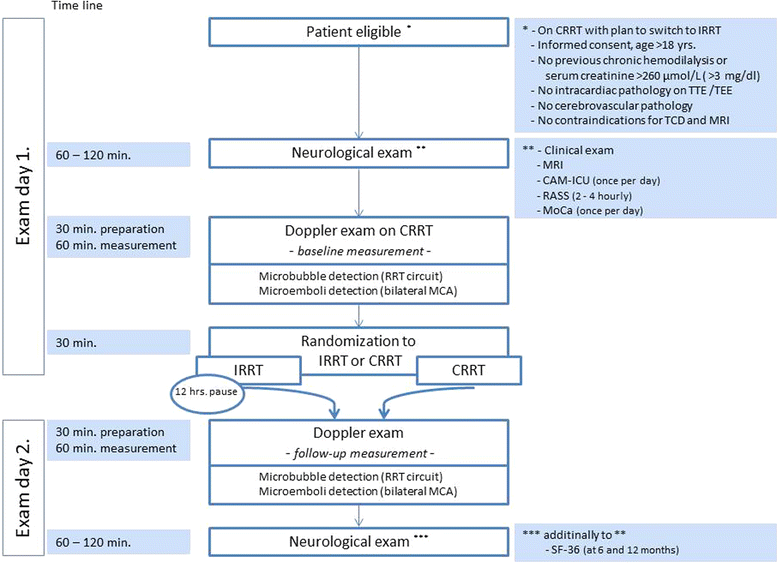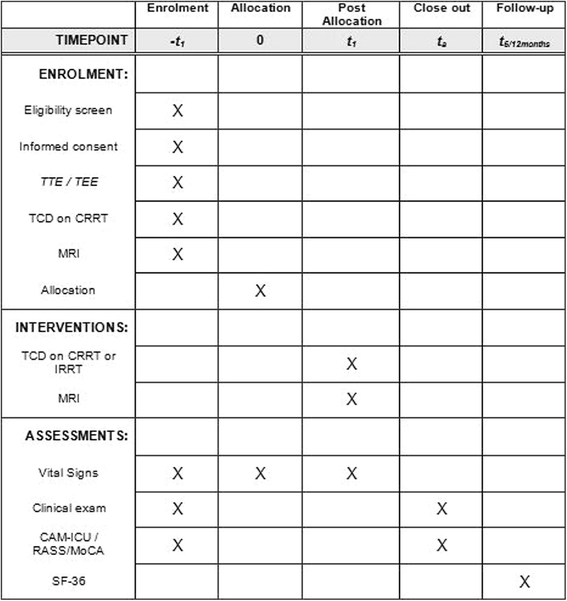Cerebral microembolism in the critically ill with acute kidney injury (COMET-AKI trial): study protocol for a randomized controlled clinical trial
- PMID: 29562937
- PMCID: PMC5861658
- DOI: 10.1186/s13063-018-2561-3
Cerebral microembolism in the critically ill with acute kidney injury (COMET-AKI trial): study protocol for a randomized controlled clinical trial
Abstract
Background: Microembolism is a frequent pathological event during extracorporeal renal replacement therapy (RRT). Some previous data indicate that microemboli are generated in patients who are undergoing RRT and that these may contribute to increased cerebrovascular and neurocognitive morbidity in patients with end-stage renal disease. The current trial aims to quantify the microembolic load and respective qualitative composition that effectively reaches the intracerebral circulation in critically ill patients treated with different RRT modalities for acute kidney injury (AKI).
Methods/design: The COMET-AKI trial is a prospective, randomized controlled clinical trial with a 2-day clinical assessment period and follow-up visits at 6 and 12 months. Consecutive critically ill patients with AKI on continuous renal replacement therapy (CRRT) scheduled for a switch to intermittent renal replacement therapy (IRRT) will be randomized to either switch to IRRT within the next 24 h or continued CRRT for an additional 24 h. Cerebral microembolic load will be determined at baseline, i.e., before switch (on CRRT for both groups) and on IRRT versus CRRT, whichever group they were randomized to. The primary endpoint is defined as the difference in mean total cerebral microemboli count during the measurement period on CRRT versus IRRT following randomization. Microemboli will be assessed within the RRT circuit by a 1.5-MHz ultrasound detector attached to the venous RRT tubing and cerebral microemboli will be measured in the middle cerebral artery using a 1.6-MHz robotic transcranial Doppler system with automatic classification of Doppler signals as solid or gaseous. In addition to Doppler measurements, patients will be examined by magnetic resonance imaging and neurocognitive tests to gain better understanding into the potential morphological and clinical consequences of embolization.
Discussion: The results of COMET-AKI may help to gain a better insight into RRT modality-associated differences regarding microbubble generation and the cerebral microembolic burden endured by RRT recipients. Furthermore, identification of covariates of microbubble formation and distribution may help to encourage the evolution of next-generation RRT circuits including machinery and/or filters.
Trial registration: ClinicalTrials.gov, ID: NCT02621749 . Registered on 3 December 2015.
Keywords: Acute kidney injury; Cerebral microembolism; Critically ill patients; Renal replacement therapy.
Conflict of interest statement
Ethics approval and consent to participate
The study with the current protocol (version 3.0) has received ethical approval by the Cantonal Ethics Committee on 16 December 2015 (approval number 199/15) and has been registered at ClinicalTrials.gov under the identifier: NCT02621749. All study participants must provide written informed consent prior to any study-specific procedure.
Consent for publication
Not applicable.
Competing interests
The authors declare that they have no competing interests.
Publisher’s Note
Springer Nature remains neutral with regard to jurisdictional claims in published maps and institutional affiliations.
Figures


Similar articles
-
Delivered dose of renal replacement therapy and mortality in critically ill patients with acute kidney injury.Crit Care. 2009;13(2):R57. doi: 10.1186/cc7784. Epub 2009 Apr 15. Crit Care. 2009. PMID: 19368724 Free PMC article.
-
VolumE maNagement Under body composition monitoring in critically ill patientS on CRRT: study protocol for a randomized controlled trial (VENUS trial).Trials. 2018 Dec 12;19(1):681. doi: 10.1186/s13063-018-3056-y. Trials. 2018. PMID: 30541593 Free PMC article.
-
Initial renal replacement therapy (RRT) modality associates with 90-day postdischarge RRT dependence in critically ill AKI survivors.J Crit Care. 2024 Aug;82:154764. doi: 10.1016/j.jcrc.2024.154764. Epub 2024 Mar 8. J Crit Care. 2024. PMID: 38460295
-
Renal replacement therapy in the ICU: intermittent hemodialysis, sustained low-efficiency dialysis or continuous renal replacement therapy?Curr Opin Crit Care. 2018 Dec;24(6):437-442. doi: 10.1097/MCC.0000000000000541. Curr Opin Crit Care. 2018. PMID: 30247213 Review.
-
Effects of renal replacement therapy on renal recovery after acute kidney injury.Nephron Clin Pract. 2014;127(1-4):35-41. doi: 10.1159/000363671. Epub 2014 Sep 24. Nephron Clin Pract. 2014. PMID: 25343818 Review.
References
Publication types
MeSH terms
Associated data
Grants and funding
LinkOut - more resources
Full Text Sources
Other Literature Sources
Medical

